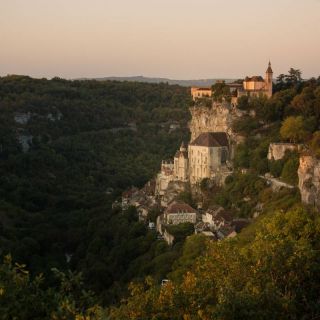
The Padirac chasm, a must-see in the Lot region
In the heart of the Causse du Quercy in the Lot department, the Padirac chasm is France's leading underground site. Famous the world over, it invites you to take a trip to the centre of the Earth, while remaining close to the Brive basin.
After descending 103 metres underground, either by lift or, if you're feeling brave, by the stairs, you'll take a boat for a ride on the underground river, accompanied by your guide. As the vault rises, a fault opens up, revealing the Rain Lake, so called because of the thousands of drops of water that fall from the vault. This is when you come face to face with the Grande Pendeloque, a 60m-high stalactite. You dock and continue your visit on foot to the Grand Dôme room. A veritable underground cathedral with a 94 m high ceiling, it offers the most majestic viewpoint of the route, before finishing with the Gours lake.
5 good reasons to visit Gouffre de Padirac
- Dive like a Jules Verne hero into the heart of France's first underground site.
- Sail for 1 km on the Plane river in silence and calm.
- Marvel at the incredible natural heritage created by erosion.
- Discover rare animal species, some of which are endemic.
- Take part in an "Explorers" evening and experience an exceptional and privileged adventure, just as Edouard-Alfred Martel did in 1889.
Padirac, between legend and scientific reality
The legend of the Padirac chasm
The Padirac chasm, 35 metres in diameter, has long been known as "The Devil's Hole". The name actually comes from a legend that explains the birth of the site. One day, when Saint Martin was walking in the Lot countryside to help lost souls, the Devil himself appeared and challenged him to cross a huge hole he had dug with his heel. And so the Padirac chasm was born (and to finish the story: Saint Martin brilliantly overcame the obstacle, much to the despair of Satan, who took refuge in the bowels of the Earth).

How was the Padirac chasm formed?
A legend is all very well, but it doesn't explain the scientific and geological reality surrounding the formation of the chasm. To understand this, we need to go back a long, long way. In the Jurassic era, a sea covered the present-day site of the Lot and even more. Eventually, the water receded, leaving behind an immense limestone plateau. When the Pyrenees were formed, the movements of the tectonic plates that formed the mountain range created faults and fissures in this limestone plateau. Gradually, the water infiltrated until, 1 or 2 million years ago, it formed underground galleries that we can walk through today, once we have passed the chasm. The "chasm" is the immense shaft through which you descend by lift or on foot. It is thought to have formed when the vault of an underground chamber collapsed several hundred thousand years ago.
Human exploration of the Padirac chasm
The gigantic size of the Padirac chasm and the mysteries that surround it have always fascinated mankind. But it was only in the 19th century that a few curious people plucked up the courage to explore this fascinating gap in the ground. The first campaign began in 1867. Unfortunately, it didn't go very deep. In 1889, Edouard-Alfred Martel went down again with three of his friends. They ventured to a depth of more than 400 m, but were stopped by the underground river. They returned later with a boat and it was there that they discovered the stalactites, stalagmites, gours and other gems of Padirac. Subsequent expeditions brought to light the Grande Pendeloque and the Grand Dôme chamber. On 10 April 1899, the abyss shared its marvellous natural heritage with the public for the first time. Today, the site is on the list of the hundred longest underground cavities. 42 km of galleries have been explored, but there are still many more areas to discover...
A little abyss vocabulary
If you decide to go deep into the bowels of the Earth at Padirac, you may find these few notions of geological vocabulary useful.
- A concretion is a formation formed by the deposition of limestone contained in drops of water.
- A stalagmite is an upward-facing limestone formation. It is called a "candle" when its top is less than 10 m high. When it is more than 10 m high, it is called a "plateau stalagmite".
- A stalactite is a downward-facing limestone formation.
- Gours are natural dams formed in underground flows.
Is there life at the bottom of the abyss?
The underground fauna at Padirac is as rich as it is varied, with 70 animal species recorded. Eleven varieties of bat, for example, live at the entrance to the cave. At the far end of the cave, the River Plane flows for around 20 km before emptying into the Dordogne. It is home to a variety of living creatures, including Niphargus shrimps and the tiny snail known as the Bythinelle de Padirac. And what about man?

Excavations carried out in the chasm have revealed remains of objects dating back to the 14th century. The most likely explanation is that inhabitants of the village of Padirac took refuge there to escape persecution by the English during the Hundred Years' War. However, the chasm was also used as a saltpetre quarry in the 16th century.
Practical information
Where is the Padirac chasm?
Located in the commune of Padirac in the north-east of the Lot département, the Padirac chasm is 55 km from Brive, 30 km from Souillac and 12 km from Gramat. The journey from Brive takes around an hour by car.
Services available at the Padirac chasm
Free parking nearby - Picnic area - Snack bar and restaurant on site - Shop/bookshop - Children's play area and play park.
For more information, consult our practical guide to the Gouffre de Padirac here...

Share this article
Or share the link
You will also like...


